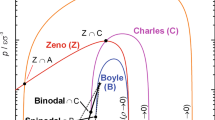Abstract
In this work, a new model based on the Wilson solution theory was proposed for predicting the solubility of solids in supercritical fluid (SCF) with and without cosolvent(s) of binary and ternary systems via computation of activity coefficients. For binary systems the model contains two adjustable parameters, while for ternary systems there are four adjustable parameters. The calculated results of the proposed model were compared with that of the literature models, and it is shown that the proposed model is a more accurate one.
Similar content being viewed by others
References
Ashour, I., Almehaideb, R., Fateen, S. E. and Aly, G., “Representation of solid-supercritical fluid phase equilibria using cubic equation ofstate,”Fluid Phase Equilibrium, 167, 41 (2000).
Baek, J. K., Kim, S., Lee, G. S. and Shim, J. J., “Density correlation of solubility of C.I. disperse orange 30 dye in supercritical carbon dioxide,”Korean J. Chem. Eng., 21, 230 (2004).
Bamberger, T., Erickson, J. C. and Cooney, C. L., “Measurement and model prediction of solubilities of pure fatting acids, pure triglycerides, and mixtures of triglycerides in supercritical carbon dioxide,”J. Chem. Eng. Data, 33, 327 (1988).
Bush, D. and Echert, C. A., “Prediction of solid-fluid equilibria in super-critical carbon dioxide using linear solvation energy relationships,”Fluid Phase Equilibrium, 150-151, 479 (1998).
Chen, P., Tang, M. and Chen, Y., “Calculations of the solubility of solids in supercritical fluids using the Peng-Robinson equation of state and a modified mixing model,”Ind. Eng. Chem. Res.,34, 332 (1995).
Chrastil, J., “Solubility of solids and liquids in supercritical gases,”J. Phys. Chem., 86, 3016 (1982).
Chun, B.-S., Lee, H.-G., Cheon, J.-K. and Wilkinson, G., “Mass transfer in a countercurrent spray column at supercritical conditions,”Korean J. Chem. Eng., 13, 234 (1996).
Dobbs, J. M., Wong, J. M. and Lahiere, R. J., “Modification of super-critical fluid phase behavior using polar cosolvents,”Ind. Eng. Chem. Res., 26(1), 56 (1987).
Gurdial, G. S. and Foster, N. R., “Solubility of O-hydroxybenzoic acid in supercritical carbon dioxide,”Ind. Eng. Chem. Res., 30, 575 (1991).
Hwang, J., Kim, C. H. and Lim, G. B., “Experimental studies and discrete thermodynamic modeling on supercritical CO2 extractions of a hexadecane and crude oil,”Korean J. Chem. Eng., 12, 244 (1995).
Hu, Y.,Molecule thermodynamics of fluid, High Education Press, Beijing, pp. 310–464 (1982).
Johnston, K. P. and Eckert, C. A., “Modeling supercritical mixtures: How predictive is it?,”Ind. Eng. Chem. Res., 28, 1115 (1989).
Kim, Y.-H., Lee, Y.-W. and Park, J.-K., “Supercritical carbon dioxide debinding in metal injection molding (MIM) process,”Korean J. Chem. Eng., 19, 986(2002).
Li, Q., Zhang, Z., Zhong, C., Liu, Y. and Zhou, Q., “Solubility of solid solutes in supercritical carbon dioxide with and without cosolvents,”Fluid Phase Equilibrium, 207, 183 (2003a).
Li, Q., Zhong, C., Zhang, Z., Liu, Y. and Zhou, Q., “An equilibrium model for the correlation of the solubility of solids in supercritical fluids with cosolvent,”Sep. Sci. & Tech., 38, 1705 (2003b).
Li, Q., Zhong, C., Zhang, Z. and Zhou, Q., “Modeling of the solubility of solid solutes in supercritical CO2 with and without cosolvent using solution theory,”KoreanJ. Chem. Eng., 21, 1173 (2004).
Mendez-Santiago, J. and Teja, A. S., “The solubility of solids in super-critical fluids,”Fluid Phase Equilibrium, 158-160, 501 (1999).
Noh, M. J., Kim, T. G., Hong, I. K. and Yoo, K. P., “Measurements and correlation of effect of cosolvents on the solubilities of complex molecules in supercritical carbon dioxide,”Korean J. Chem. Eng.,12, 48(1995).
Reid, R. C., Prausnitz, J. M. and Poling, B. E.,The properties of gases andliquid, 4th Edition, McGraw-Hill, New York, pp. 102–151 (1987).
Soave, G., “A simple model for the supercritical extraction of solids,”Journal of Supercritical Fluids, 19, 19 (2000).
Valderrama, J. O. and Silva, A., “Modified Soave-Redlich-Kwong equations of state applied to mixtures containing supercritical carbon dioxide,”KoreanJ. Chem. Eng., 20, 709 (2003).
Yau, J.-S. and Tsal, F.-N., “Solubility of 1-hexadecanol and 1-octadecanol in subcritical and supercritical carbon dioxide,”J. Chem. Eng. Data, 37, 285 (1992).
Yau, J.-S. and Tsal, F.-N., “Solubility of 1-eicosanol and eicosanoic acid in supercritical carbon dioxide from 308.2 K at pressures to 21.26 MPa,”J. Chem. Eng. Data,39, 827 (1994).
Yoo, K.-P., Shin, H.-Y., Noh, M.-J. and You, S.-S., “Measurement and modeling solubility of bioactive coumarin and its derivatives in super-critical carbondioxide,”Korean J. Chem. Eng., 14, 341 (1997).
Zhu, Z.,Supercritical fluid technology-principals and applies, Chemical Engineering Press, Beijing, pp. 61–133 (2000).
Zigger, D. H. and Eckert, C. A., “Correlation and prediction of solid-supercritical fluid phase equilibria,”Ind. Eng. Chem. Process Des. Dev., 22, 582 (1983).
Author information
Authors and Affiliations
Corresponding author
Rights and permissions
About this article
Cite this article
Wang, B., Li, Q., Zhang, Z. et al. A new model for predicting solute solubility in supercritical fluids based on the Wilson equation. Korean J. Chem. Eng. 23, 131–137 (2006). https://doi.org/10.1007/BF02705704
Received:
Accepted:
Issue Date:
DOI: https://doi.org/10.1007/BF02705704




